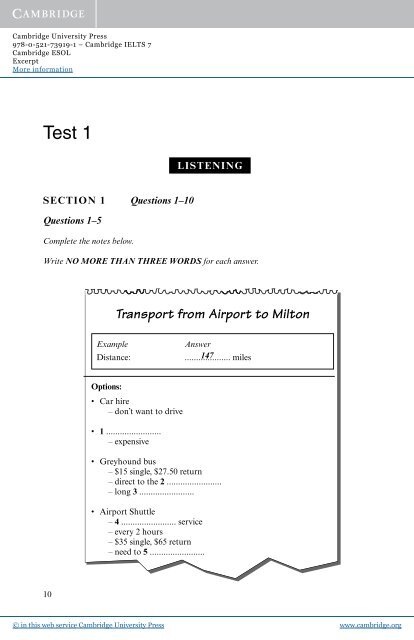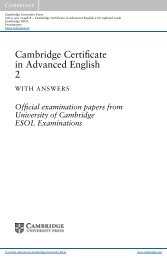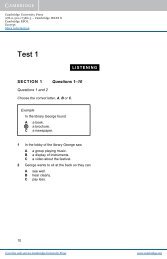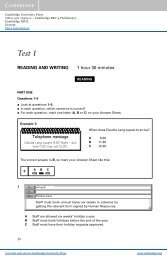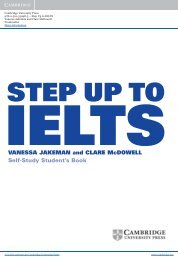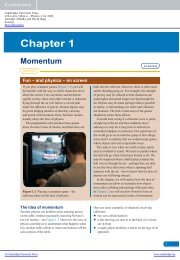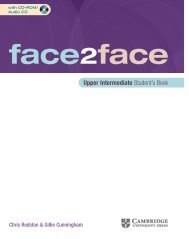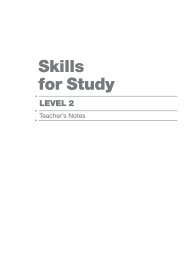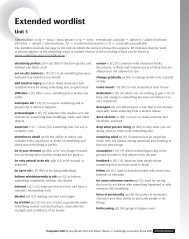Test 1 - Assets - Cambridge - Cambridge University Press
Test 1 - Assets - Cambridge - Cambridge University Press
Test 1 - Assets - Cambridge - Cambridge University Press
- No tags were found...
You also want an ePaper? Increase the reach of your titles
YUMPU automatically turns print PDFs into web optimized ePapers that Google loves.
<strong>Cambridge</strong> <strong>University</strong> <strong>Press</strong>978-0-521-73919-1 – <strong>Cambridge</strong> IELTS 7<strong>Cambridge</strong> ESOLExcerptMore information<strong>Test</strong> 1XLISTENINGXSECTION 1 Questions 1–10Questions 1–5Complete the notes below.Write NO MORE THAN THREE WORDS for each answer.Transport from Airport to MiltonExampleDistance:Answer.................... 147 milesOptions:• Car hire– don’t want to drive• 1 ........................–expensive• Greyhound bus– $15 single, $27.50 return– direct to the 2 ........................–long 3 ........................• Airport Shuttle– 4 ........................ service– every 2 hours– $35 single, $65 return– need to 5 ........................10© in this web service <strong>Cambridge</strong> <strong>University</strong> <strong>Press</strong> www.cambridge.org
<strong>Cambridge</strong> <strong>University</strong> <strong>Press</strong>978-0-521-73919-1 – <strong>Cambridge</strong> IELTS 7<strong>Cambridge</strong> ESOLExcerptMore information<strong>Test</strong> 1SECTION 2 Questions 11–20Questions 11–16Choose the correct letter, A, B or C.11 PS Camping has been organising holidays forA 15 years.B 20 years.C 25 years.12 The company has most camping sites inA France.B Italy.C Switzerland.13 Which organised activity can children do every day of the week?A footballB dramaC model making14 Some areas of the sites have a ‘no noise’ rule afterA 9.30 p.m.B 10.00 p.m.C 10.30 p.m.15 The holiday insurance that is offered by PS CampingA can be charged on an annual basis.B is included in the price of the holiday.C must be taken out at the time of booking.16 Customers who recommend PS Camping to friends will receiveA a free gift.B an upgrade to a luxury tent.C a discount.12© in this web service <strong>Cambridge</strong> <strong>University</strong> <strong>Press</strong> www.cambridge.org
<strong>Cambridge</strong> <strong>University</strong> <strong>Press</strong>978-0-521-73919-1 – <strong>Cambridge</strong> IELTS 7<strong>Cambridge</strong> ESOLExcerptMore information<strong>Test</strong> 1SECTION 3 Questions 21–30Questions 21–23Complete the notes below.Write ONE WORD ONLY for each answer.DIFFERENCES BETWEEN INDIVIDUALSIN THE WORKPLACEIndividuals bring different:• ideas• 21 ........................• learning experiencesWork behaviour differences are due to:• personality• 22 ........................Effects of diversity on companies:Advantage: diversity develops 23 ........................Disadvantage: diversity can cause conflict14© in this web service <strong>Cambridge</strong> <strong>University</strong> <strong>Press</strong> www.cambridge.org
<strong>Cambridge</strong> <strong>University</strong> <strong>Press</strong>978-0-521-73919-1 – <strong>Cambridge</strong> IELTS 7<strong>Cambridge</strong> ESOLExcerptMore informationListeningQuestions 24–27Choose the correct letter, A, B or C.24 Janice thinks that employers should encourage workers who areABCpotential leaders.open to new ideas.good at teamwork.25 Janice suggests that managers may find it difficult toABCform successful groups.balance conflicting needs.deal with uncooperative workers.26 Janice believes employers should look for job applicants whoABCcan think independently.will obey the system.can solve problems.27 Janice believes managers shouldABCQuestions 28–30demonstrate good behaviour.encourage co-operation early on.increase financial incentives.Complete the sentences below.Write ONE WORD ONLY for each answer.28 All managers need to understand their employees and recognise their company’s........................ .29 When managing change, increasing the company’s ........................ may be moreimportant than employee satisfaction.30 During periods of change, managers may have to cope with increased amounts of........................ .15© in this web service <strong>Cambridge</strong> <strong>University</strong> <strong>Press</strong> www.cambridge.org
<strong>Cambridge</strong> <strong>University</strong> <strong>Press</strong>978-0-521-73919-1 – <strong>Cambridge</strong> IELTS 7<strong>Cambridge</strong> ESOLExcerptMore information<strong>Test</strong> 1SECTION 4 Questions 31–40Questions 31–35Complete the notes below.Write ONE WORD ONLY for each answer.SEMINAR ON ROCK ARTPreparation for fieldwork trip to Namibia in 31 ........................Rock art in Namibia may be• paintings• engravingsEarliest explanation of engravings of animal footprintsThey were used to help 32 ........................ learn about trackingBut:• Why are the tracks usually 33 ........................ ?• Why are some engravings realistic and others unrealistic?• Why are the unrealistic animals sometimes half 34 ........................ ?More recent explanation:Wise men may have been trying to control wild animals with 35 ........................ .Comment:Earlier explanation was due to scholars over-generalising from their experience of adifferent culture.16© in this web service <strong>Cambridge</strong> <strong>University</strong> <strong>Press</strong> www.cambridge.org
<strong>Cambridge</strong> <strong>University</strong> <strong>Press</strong>978-0-521-73919-1 – <strong>Cambridge</strong> IELTS 7<strong>Cambridge</strong> ESOLExcerptMore information<strong>Test</strong> 1XREADINGXREADING PASSAGE 1You should spend about 20 minutes on Questions 1–13, which are based on Reading Passage 1below.Let’sGoBatsABCBats have a problem: how to find their way around in the dark. They hunt at night, and cannotuse light to help them find prey and avoid obstacles. You might say that this is a problem of theirown making, one that they could avoid simply by changing their habits and hunting by day. Butthe daytime economy is already heavily exploited by other creatures such as birds. Given thatthere is a living to be made at night, and given that alternative daytime trades are thoroughlyoccupied, natural selection has favoured bats that make a go of the night-hunting trade. It isprobable that the nocturnal trades go way back in the ancestry of all mammals. In the timewhen the dinosaurs dominated the daytime economy, our mammalian ancestors probably onlymanaged to survive at all because they found ways of scraping a living at night. Only after themysterious mass extinction of the dinosaurs about 65 million years ago were our ancestors ableto emerge into the daylight in any substantial numbers.Bats have an engineering problem: how to find their way and find their prey in the absence oflight. Bats are not the only creatures to face this difficulty today. Obviously the night-flyinginsects that they prey on must find their way about somehow. Deep-sea fish and whales havelittle or no light by day or by night. Fish and dolphins that live in extremely muddy water cannotsee because, although there is light, it is obstructed and scattered by the dirt in the water. Plentyof other modern animals make their living in conditions where seeing is difficult or impossible.Given the questions of how to manoeuvre in the dark, what solutions might an engineerconsider? The first one that might occur to him is to manufacture light, to use a lantern or asearchlight. Fireflies and some fish (usually with the help of bacteria) have the power tomanufacture their own light, but the process seems to consume a large amount of energy.Fireflies use their light for attracting mates. This doesn’t require a prohibitive amount of energy:a male’s tiny pinprick of light can be seen by a female from some distance on a dark night, sinceher eyes are exposed directly to the light source itself. However, using light to find one’s ownway around requires vastly more energy, since the eyes have to detect the tiny fraction of thelight that bounces off each part of the scene. The light source must therefore be immensely18© in this web service <strong>Cambridge</strong> <strong>University</strong> <strong>Press</strong> www.cambridge.org
<strong>Cambridge</strong> <strong>University</strong> <strong>Press</strong>978-0-521-73919-1 – <strong>Cambridge</strong> IELTS 7<strong>Cambridge</strong> ESOLExcerptMore informationReadingDEbrighter if it is to be used as a headlight to illuminate the path, than if it is to be used as a signalto others. In any event, whether or not the reason is the energy expense, it seems to be thecase that, with the possible exception of some weird deep-sea fish, no animal apart from manuses manufactured light to find its way about.What else might the engineer think of? Well, blind humans sometimes seem to have an uncannysense of obstacles in their path. It has been given the name ‘facial vision’, because blind peoplehave reported that it feels a bit like the sense of touch, on the face. One report tells of a totallyblind boy who could ride his tricycle at good speed round the block near his home, using facialvision. Experiments showed that, in fact, facial vision is nothing to do with touch or the front ofthe face, although the sensation may be referred to the front of the face, like the referred painin a phantom limb. The sensation of facial vision, it turns out, really goes in through the ears.Blind people, without even being aware of the fact, are actually using echoes of their ownfootsteps and of other sounds, to sense the presence of obstacles. Before this was discovered,engineers had already built instruments to exploit the principle, for example to measure thedepth of the sea under a ship. After this technique had been invented, it was only a matter oftime before weapons designers adapted it for the detection of submarines. Both sides in theSecond World War relied heavily on these devices, under such codenames as Asdic (British) andSonar (American), as well as Radar (American) or RDF (British), which uses radio echoes ratherthan sound echoes.The Sonar and Radar pioneers didn’t know it then, but all the world now knows that bats, orrather natural selection working on bats, had perfected the system tens of millions of yearsearlier, and their ‘radar’ achieves feats of detection and navigation that would strike an engineerdumb with admiration. It is technically incorrect to talk about bat ‘radar’, since they do not useradio waves. It is sonar. But the underlying mathematical theories of radar and sonar are verysimilar, and much of our scientific understanding of the details of what bats are doing has comefrom applying radar theory to them. The American zoologist Donald Griffin, who was largelyresponsible for the discovery of sonar in bats, coined the term ‘echolocation’ to cover bothsonar and radar, whether used by animals or by human instruments.19© in this web service <strong>Cambridge</strong> <strong>University</strong> <strong>Press</strong> www.cambridge.org


